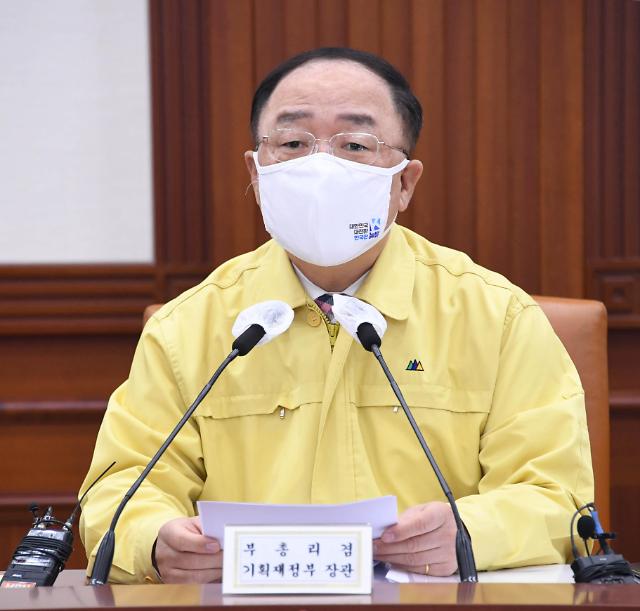Decrease in the number of employed 218,000 people…maximum in 22 years
In the face-to-face service industry, the number of young, temporary, and daily workers decreased significantly
Job prospects for January-February unclear… urgently needed to induce private job creation

On the 13th, Vice Prime Minister Hong Nam-ki and Minister of Strategy and Finance held the ’26th Emergency Economy Central Countermeasure Headquarters Meeting and the 9th Korean Version of New Deal Ministers’ Meeting’ at the Seoul Government Building and are making a speech.[사진=기획재정부]
It was an expected job disaster. In the past year when Corona 19 hit, the employment situation, including the number of employed, was the worst since the 1998 International Monetary Fund (IMF) financial crisis.
In the midst of corporate management difficulties, the recruitment door for young people was firmly closed, and jobs fell sharply, mainly due to the vulnerable, such as temporary and daily workers, leading to the number of unemployed. The number of people who gave up looking for a job or just taking a break increased sharply, recording a record high since statistics.
The outlook for employment this year is also uncertain. Private companies announced their hiring plan for the first quarter of this year was 253,000, the lowest ever.
The government seriously looked at the employment situation and announced plans to directly hire more than 800,000 jobs in the first quarter of this year. However, as government-led direct jobs are limited, there is a strong voice that the private sector should increase its capacity to create jobs.
◇ Face-to-face service industry, the number of young, temporary, and daily workers decreased significantly…the largest in 22 years
According to the’December 2020 and Annual Employment Trends’ released by the National Statistical Office on the 13th, the number of employees employed per year last year was 26.94,000, down 218,000 from a year ago. This is the largest decline in 22 years since 1998 (-1276,000 people) during the IMF financial crisis.
In addition to the financial crisis, the number of employed people decreased in 1984 (-76,000 people), when the oil shock struck, 2003 (-10,000 people), when the card crisis broke out, and in 2009 (-87,000 people) right after the global financial crisis. It was a total of 4 times.
By age, the number of young people in their 30s (–165,000) and 20s (–146,000) saw a significant decline in the number of employed. The number of people in their 40s (-158,000) and 50s (-88,000) who are responsible for family living decreased. Thanks to government public jobs, the number of people aged 60 and over has increased by 375,000.
By industry, in the aftermath of Corona 19, face-to-face service sectors such as wholesale and retail (160,000 people), accommodation and restaurant (-159,000 people), and education service (-86,000 people) were remarkable.
Temporary and daily workers, who are vulnerable to jobs, were more affected by Corona 19. Among wage workers, the number of regular workers increased by 305,000, but the number of temporary workers decreased by 313,000 and the number of daily workers decreased by 101,000.
Last year, the employment rate fell and the unemployment rate soared. The total employment rate for the ages of 15 to 64 was 65.9%, down 0.9 percentage points from the previous year, and the youth employment rate also fell 1.3 percentage points to 42.2%.
The number of unemployed people increased by 45,000 to 1.18,000, the highest since 2000, when the statistics were changed. The unemployment rate was also 4.0%, the highest since 2001. The unemployment rate experienced by youth was also the highest ever at 26.0%.
The number of inactive people who left economic activity was 16,773,000, an increase of 455,000 (2.8%) from the previous year.
The number of people who just rest here was 2,374,000, a surge of 282,000 (13.5%) from the previous year, the highest since the statistics were written. The number of those who gave up job hunting was 65,000, the highest since 2014, an increase of 73,000 (13.6%) compared to the previous year.

Annual Employment Trend in 2020[자료=통계청]
◇ January-February employment prospects are uncertain…
For the time being this year, the worst employment situation due to the impact of Corona 19 is expected to continue. The job market usually lags behind the economic recovery, so it does not lead to a job recovery.
Deputy Prime Minister Hong Nam-ki and Minister of Strategy and Finance also held a meeting at the Emergency Economy Central Countermeasure Headquarters and the Ministers’ Meeting for the Korean New Deal, saying, “The tough employment situation will continue until January and February.”
The government has announced that it will hire more than 45% of the number of employees employed by public institutions within the first half of this year. The number of new recruits for public institutions this year is expected to be around 30,000, an increase from 25,700 last year. The 1,040,000 direct job projects are also planned to be hired in March with more than 800,000 starting from the beginning of the year.
Some point out that in order to recover the employment situation this year, there is an urgent need for support measures to revitalize the private sector and lead to job creation.
Se-don Shin, an emeritus professor at Sookmyung Women’s University, said, “As the statistics show, direct jobs of the government are limited to the effect of temporarily increasing the number of jobs for the elderly.” “We need support measures such as giving incentives to people.”
©’Five-language global economic newspaper’ Ajou Economy. Prohibition of unauthorized reproduction and redistribution
